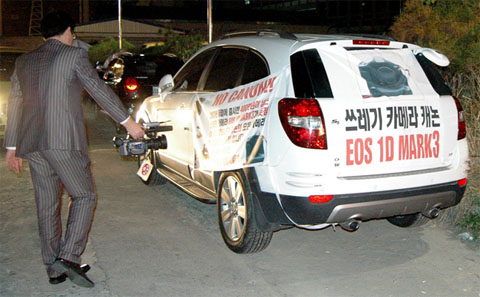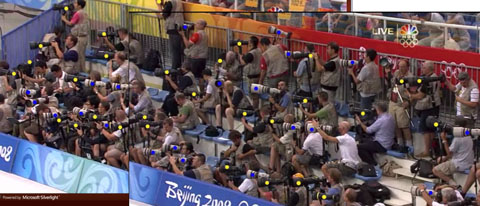Canon’s DSLR division in trouble

In the picture above you can see a car belonging to a Korean photographer, with banners attached containing a message about Canon’s EOS 1D Mark III camera. The text on those banners translates to: “Camera that is a piece of trash – Canon EOS 1D Mark 3.” Apparently, the problems with this camera drove the photographer so insane, he printed these banners and put them on his car to let the world know about it. Full picture and article can be found here. I can’t help but think that this guy spent his savings on this camera only to find out what a bad investment it turned out to be. Even the $8000 EOS 1Ds Mark III camera suffers from the same issues the 1D Mark III has. Imagine spending $8000 on that camera, and finding out you can’t use it for serious work.
And yet, this is the situation many photographers around the world have found themselves in, thanks to Canon. If you are new to this, I have written about all the quality control issues at Canon a few times already, just start looking here. Not only Canon camera bodies have problems, but even their lenses often contain issues right out of the box.
So after the release of the Nikon D3 and more recently D700, it’s no surprise that photographers everywhere seem to be switching to these camera’s. And it shows at major events. It showed at the Tour de France, and right now at the Olympics:

Photographer Michael Reichmann has made similar comments here:
In addition to being a fun perspective on a group of pros at work it’s also a sign of the times to note the number of Nikons (black) vs. the number of Canons (white) in the shot. For the past 10 years or so at almost any major sporting event the number of white lenses would almost always outnumber the number of black lenses by a huge margin. So much so that Canon has run magazine ads showing this disparity.
But that was then, and this is 2008. At this year’s Olympics the number of Nikons in use by pros seems to equal if not surpass the number of Canons. A definite sign of the times.
Photographer John Harrington comments on this here:
This year’s Olympics should well be the turning point where the sidelines of sporting events are – to pay homage to AC/DC – Back in Black. Nikon’s flagship D3 – even with a smaller chip than it’s competition the Canon EOS 1Ds Mark III (and even it’s predecessor the 1Ds Mark II) has painted the sidelines at the Olympics (and so too, the news event press pens in DC) more and more black. (Click the photo to see it larger). This is substantially due to Nikon’s high ISO – insane at 25,600 ISO, and amazingly useful at 3200 and 6400 ISO without having to even think about it much. To add to this huge lead, consider Canon’s faltering with the autofocus mis-steps as highlighted by Rob Galbraith (repeatedly).
In a few days, I’m headed overseas on assignment for two weeks, and I’ll be working in mostly low-light museums and other national treasures in several countries. Even though I own an EOS 1Ds Mark III, and Mark II, instead, I am choosing to take my D3, and a D700 as well. It really was a no-brainer given the multiple times I won’t be allowed to use flash – but still am required by my client to make images during the trip. My Canons will sit in the equipment cabinet back in the office.
And as Harrington notes, Rob Galbraight recently released his final comments on the EOS 1D/Ds Mark III camera’s, and it doesn’t look good for Canon. Galbraith even mentions the EOS 40D:
While we haven’t written about the 40D’s autofocus performance before, we have done assignments with it and included the camera in various tests, starting at about the time it shipped in September 2007. Since then we’ve shot with four bodies, two focus-calibrated and two that came directly from the store shelf. Using focus-calibrated lenses with these bodies, the result has been the same: the 40D has real difficulties accurately picking up the focus on a moving subject and then tracking it from there.
…
A midrange digital SLR with a midrange price tag probably can’t be expected to offer the same autofocus performance as the company’s best. Even taking that into account, though, the 40D doesn’t fare well. It’s not that it can’t do the job at the level of a more expensive camera, it’s that it can’t do the job really at all.
And I have to agree, since I have experienced these issues first hand myself. For example, Galbraight wrote about the 1D Mark III:
Just enough testing was done to reveal a few things. Whereas the older firmware can introduce a change in focus distance with each One Shot activation, even if the AF point is aimed at the same subject at the same distance each time, the newer firmware seems to give more repeatable and accurate focus results under the same conditions. But if the test is done slightly differently – setting the focus to some other distance, then focusing one time on the subject using One Shot, autofocus variability seems about the same as before: there’s too much.
This same problem also exists with 40D cameras and it is very annoying because it’s unpredictable, and using it on assignments can give you (slightly) out of focus images where you don’t expect it.
Meanwhile, Canon remains quiet about all these issues that users are experiencing. Many people continue to invest large sums of money everyday in Canon DSLR bodies and lenses, only to find out they don’t work correctly out of the box.
Resale value of these items is also dropping fast right now, as Nikon has much better alternatives. I’m surprised a new defective 1D Mark III body still costs around $4000, when you can get a much better Nikon D700 with grip for about $3200. Canon must be smoking something very strong to think informed photographers are going to continue to buy the 1D Mark III at that price. But I think this reveals Canon’s strategy. And that’s a strategy of keeping quiet about the issues and not giving these problems a lot of publicity so they can continue to sell this crap to uninformed people as much as possible.
It remains to be seen what Canon will come up with later this year. They have been known to intentionally cripple products for “marketing” reasons (just look at the 40D and 5D). With Nikon now on the market with a D700 that can do almost everything the high end D3 can do, it seems Canon will have no choice but to release something at least as powerful. And if they can’t or won’t, they’re going to be in deep shit. Moreover, even if they do manage to release something better spec wise, if they can’t somehow improve the terrible quality control they currently have, they’ll continue to lose marketshare to Nikon. Because it doesn’t matter if you are the resolution leader with a 1Ds Mark III, when it can’t focus properly out of the box.

Comments
There are 16 responses. Follow any responses to this post through its comments RSS feed. You can leave a response, or trackback from your own site.